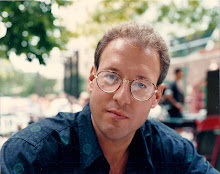So to what frequency do consumers tune when dialing in your business? Are you broadcasting a frequency only they can hear? That sure would cut clutter! Why ask this question? Because we all operate with our own definitions of positioning, insight, branding, ad nauseum. And they can't all be correct. There is an overburden of clutter, commoditization and desensitization to ad messages in the marketplace. So how do you tune into that one frequency that reaches that one person (thought leader, early adapter, whatever) that you want to hear your message?
About 24 million consumers ago (that's about how many consumer panelists we've intereacted with face-to-face/not online in the last 40 years) we determined that the insight you want to target is called a Special User Effect. It is not a generic emotion of the sort generated by Hal Riney for Saturn. That division still operates in the red. A Special User Effect is consumer-created (not Madison Avenue or client created) and it is the result of a process that creates new consumer knowledge that has never previously existed to be mapped, gathered or measured. It is not the product of your own mind, my own mind or insight either.
This places the bar higher. That's where "development" came from for Pampers, which grew the business by $1.6 billion that year (now that's an insight). It's also the way the oral care business determined the five category attributes that account for all consumer perceptions in oral care. So I don't really care which agency you are or you hire. Every insight they have will in some way shape or form be somehow inextricably tied to one or more of these five attributes unless you create new breakthrough knowledge. We only brush our teeth for reasons of whitening, breath freshening (includes germ killing), gum care, tartar control and cavity prevention.
Why do I make such a hard line stance and draw my line in the sand here? Because my goal is higher. I don't just sell more product with garden variety insights. I control the definition of categories with the proprietary ability to create new knowledge from the minds of consumers. That's consumer-creativity and it is not the same as merely soliciting user generated input from websites where provided input comes only from consumer's existing frames of reference. Companies only do that because it's cheap. No matter how hard you study the past [that way] it can never give you everything you need for the present.
A brand IS fewer things to fewer people. That is what causes the early adapters to glom on. The novelty is what gives a brand an allure. Then they 9the numbers crunchers and insight hounds) try to make it more things to more people and you can kiss it goodbye. Everyone else is just a follower. A brand IS something that someone started that caught on. The rest of us are merely members of the herd. How do you resurrect a company like GM or a brand like Starbucks? It can only come from the creation of new knowledge. Closing 600 stores, recipe dissemination, a few novelty fro-yo drinks and a MyStarbucksIdea website will not improve Starbucks fortune. They are merely stabilizers and are only preparatory moves to Howard Schultz making another kind of decision, like cashing out.
The frequencies of insights are deafening. There are so many so inconsequential insights echoing against the fundamental building blocks of categories - any category - that we tune them out - noise - commodities we take for granted - which is why agencies and managers get hired and fired all the time. The insights that matter are those that fundamentally change perception in a category and substantively alter consumer habits and practices to a desired goal, solving problems. To that end, there can only be one insight - the rest are all peasants.





2 comments:
Who can explain it?
Who can tell you why?
Fools give you reasons,
Wise men never try.
--- Rodgers & Hammerstein
Advertising isn't a science.
It's persuasion.
And persuasion is an art.
--- Bill Bernbach
When I was young, an old (P&G)
brand man laid this old saw on me:
"THE EYE REMEMBERS WHAT THE EAR FORGETS."
Over the years that wisdom has been defined (by me) to mean that within all persuasions lie even deeper communications, stuff that defies logical explanations. So with regard to creative endeavors a little art goes a long way.
Original and inventive logic, when tethered to great creative, is a pretty potent thing. This commentary is a bit off-topic (from yours) but I felt like
spewing in defense of the marriage of the LOGICAL & MAGICAL.
N.
Time just skipped a beat.
Post a Comment